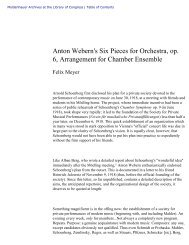Country Profile: Cuba - American Memory - Library of Congress
Country Profile: Cuba - American Memory - Library of Congress
Country Profile: Cuba - American Memory - Library of Congress
You also want an ePaper? Increase the reach of your titles
YUMPU automatically turns print PDFs into web optimized ePapers that Google loves.
<strong>Library</strong> <strong>of</strong> <strong>Congress</strong> – Federal Research Division <strong>Country</strong> <strong>Pr<strong>of</strong>ile</strong>: <strong>Cuba</strong>, September 2006<br />
Staff. The <strong>Cuba</strong>n military is divided into three major geographical commands: Western<br />
(headquartered in Havana), covering the capital and the provinces <strong>of</strong> Ciudad de La Habana and<br />
Pinar del Río; Central (headquartered in Matanzas), covering the provinces <strong>of</strong> Matanzas, Villa<br />
Clara, Cienfuegos, and Sancti Spíritus; and Eastern (headquartered in Santiago de <strong>Cuba</strong>),<br />
covering the provinces <strong>of</strong> Santiago de <strong>Cuba</strong>, Guantánamo, Granma, Holguín, Las Tunas,<br />
Camagüey, and Ciego de Ávila. Each <strong>of</strong> the three regional army commands and the Isle <strong>of</strong> Youth<br />
Autonomous Military Region has its own staff organization and reports to Raúl Castro.<br />
Foreign Military Relations: The <strong>Cuba</strong>n military has long maintained contact with the armed<br />
forces <strong>of</strong> developing world nations that are considered nonaligned or at least not ideologically<br />
hostile to the Castro regime. It was able to mitigate its post-Soviet isolation by developing closer<br />
ties with fellow military <strong>of</strong>ficers in Latin America and Europe, and its post–Cold War efforts to<br />
build contacts with foreign militaries were aided by Fidel Castro’s 1992 declaration that <strong>Cuba</strong><br />
would no longer support revolutionary movements abroad.<br />
Russia still has a December 2000 agreement with <strong>Cuba</strong> to modernize Soviet-built <strong>Cuba</strong>n military<br />
equipment, but there is little evidence that <strong>Cuba</strong>’s inventory is being modernized. Perhaps the<br />
most important tie with a foreign military force to develop since the Soviet Union’s demise has<br />
been the relationship with the Chinese Popular Liberation Army. In early 2001, China and <strong>Cuba</strong><br />
concluded an agreement to increase military cooperation. However, the Chinese-<strong>Cuba</strong>n military<br />
relationship, which appears to be more <strong>of</strong> a business arrangement, does not compare with <strong>Cuba</strong>’s<br />
former military dependency on the Soviet Union.<br />
External Threat: No neighboring Latin <strong>American</strong> or Caribbean countries pose a military threat<br />
to <strong>Cuba</strong>. The only country with a history <strong>of</strong> military intervention in <strong>Cuba</strong> since the expulsion <strong>of</strong><br />
Spain in 1898 is the United States, which maintains the U.S. naval base at Guantánamo Bay,<br />
consisting <strong>of</strong> 1,600 army, 510 naval, 80 marine, and 65 air force personnel in 2004. The Castro<br />
government has always portrayed the United States in <strong>Cuba</strong>n media as a potential military threat<br />
to <strong>Cuba</strong>, <strong>of</strong>ten using as an historical example the disastrous landing <strong>of</strong> an army <strong>of</strong> <strong>Cuba</strong>n exiles<br />
organized by the U.S. Central Intelligence Agency on Playa Girón in the Bay <strong>of</strong> Pigs on the<br />
south-central <strong>Cuba</strong>n coast on April 17, 1961. U.S. economic warfare against the island has<br />
always been a reality for the Castro government, which also portrays the U.S. threat as taking the<br />
form <strong>of</strong> support for internal subversion, human rights activism, and political interference. On<br />
August 1, 2006, claiming the country was “under threat” <strong>of</strong> U.S. aggression, Acting President<br />
Raúl Castro ordered a military mobilization <strong>of</strong> tens <strong>of</strong> thousands <strong>of</strong> reservists and militia<br />
members and the Special Troops as per plans that Fidel Castro “approved and signed on January<br />
13, 2005.”<br />
Defense Budget: <strong>Cuba</strong>’s defense budget shrank from 9.6 percent <strong>of</strong> gross domestic product<br />
(GDP) in 1985 to 2.8 percent <strong>of</strong> GDP in 1995. Over the past decade, it has remained under 4<br />
percent <strong>of</strong> GDP. <strong>Cuba</strong> does not make public its defense spending, but expenditures on defense<br />
and internal security for 2005 were estimated at US$1.7 billion, compared with US$1.1 billion in<br />
2003, US$900 million in 2002, US$789 million in 2001, and US$720 million in 1997. The 2003<br />
estimate <strong>of</strong> US$1.1 billion was the equivalent <strong>of</strong> US$97 per head <strong>of</strong> population and US$23,157<br />
per member <strong>of</strong> the armed forces. The army has become more self-reliant through greater<br />
29



![Albert Einstein Papers [finding aid]. Library of Congress. [PDF ...](https://img.yumpu.com/21604228/1/190x245/albert-einstein-papers-finding-aid-library-of-congress-pdf-.jpg?quality=85)





![American Colony in Jerusalem Collection [finding aid]. Library of ...](https://img.yumpu.com/17941275/1/190x245/american-colony-in-jerusalem-collection-finding-aid-library-of-.jpg?quality=85)



![Piccard Family Papers [finding aid]. - American Memory - Library of ...](https://img.yumpu.com/17941234/1/190x245/piccard-family-papers-finding-aid-american-memory-library-of-.jpg?quality=85)


